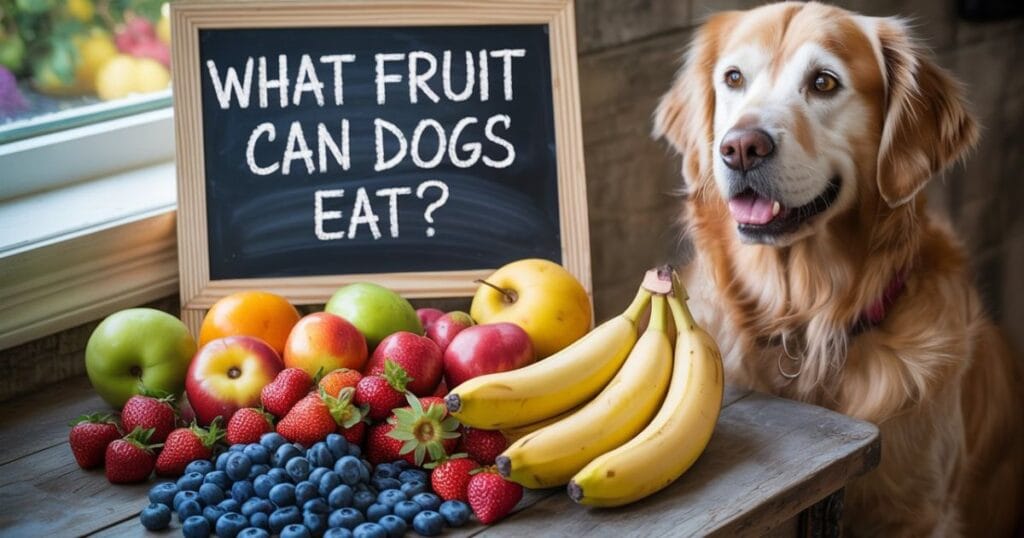As a dog owner, you’re always looking for ways to show your love and care for your furry friend. Whether it’s a belly rub, a new chew toy, or a delicious treat, you want your dog to be healthy and happy. But when it comes to treating your dog with something a little different, like a fruit, you might wonder: “What fruit can dogs eat?” This is an important question because while many fruits are healthy for us, not all of them are safe for our dogs.
In this guide, we’ll explore which fruits are safe for your dog to eat, the ones you should avoid, and tips on how to serve them in a way that ensures your dog stays healthy. From sweet, juicy berries to hydrating watermelon, we’ll cover it all—so you can treat your dog to a variety of fruits without worry.
Why Fruits Can Be a Great Treat for Dogs
You’ve probably heard that fruits are good for us. They are loaded with vitamins, minerals, and antioxidants that can help fight disease and promote overall health. The same is true for dogs. But while we may grab an apple or a handful of berries as a quick snack, dogs have different dietary needs, and some fruits are better suited to them than others.
When you feed your dog fruit, you’re not just giving them a sweet treat—they’re getting vital nutrients. Fruits can provide vitamins, fiber, and hydration, all of which contribute to your dog’s well-being. Plus, fruits are a great alternative to store-bought dog treats that may contain fillers, added sugars, or unhealthy fats.
However, it’s essential to remember that fruits should only be given in moderation. Too much fruit can upset your dog’s stomach, and some fruits contain compounds that could be harmful to them if consumed in large quantities.
What Fruits Are Safe for Dogs? A Complete List
To make things easier, we’ve put together a list of fruits that are safe for your dog. These fruits offer a range of health benefits, and most dogs will love the taste. Just remember to remove seeds, pits, and skins that may pose choking hazards or contain toxins.
Safe Fruits for Dogs:
- Apples: Apples are a great low-calorie snack that’s packed with fiber and vitamins A and C. They’re also rich in antioxidants, which help protect your dog’s cells from free radicals. Just be sure to remove the seeds, as they contain cyanide, which is toxic to dogs.
- Blueberries: These tiny berries are antioxidant powerhouses, and they are safe for dogs to enjoy. Blueberries are rich in vitamin C, fiber, and phytonutrients, which can support your dog’s immune system, improve their digestion, and boost brain function.
- Bananas: Bananas are loaded with potassium and provide a natural source of energy. They also help regulate digestion due to their fiber content. While bananas are nutritious, they’re also high in sugar, so they should be given in moderation to avoid upsetting your dog’s stomach or contributing to weight gain.
- Strawberries: Full of fiber and vitamin C, strawberries can be a refreshing treat for your dog. They also contain antioxidants that help promote healthy aging. However, because strawberries are high in sugar, they should only be given in small amounts to avoid digestive issues.
- Watermelon: Watermelon is an excellent hydrating fruit, especially in hot weather. It’s rich in water, vitamins A, B6, and C, and can help keep your dog cool and hydrated. Just be sure to remove the seeds and rind before serving it to your dog.
- Pineapple: Pineapple is another tropical fruit that’s safe for dogs. It’s full of vitamin C, manganese, and fiber, which support your dog’s immune system and digestive health. Just remember to remove the tough outer skin and core, as they can be difficult for your dog to digest.
- Peaches: Peaches are rich in vitamins A and C and can provide your dog with a healthy, hydrating snack. However, it’s crucial to remove the pit before feeding your dog, as it contains cyanide, which is toxic to dogs.
- Pears: Pears are a great source of fiber and vitamin C, and they can be a crunchy, refreshing treat for your dog. Be sure to remove the seeds and core, as these parts can cause digestive problems or even be toxic in large quantities.
- Cantaloupe: This melony fruit is a good source of vitamins A and C, both of which are essential for your dog’s immune health. The high water content of cantaloupe also makes it an excellent choice for hydration on hot days.
- Mango: Mangoes are loaded with vitamins, including vitamin A, C, and E, and they’re a great source of fiber. They support your dog’s skin and coat health, immune system, and digestive function. Just remember to remove the pit, as it can be a choking hazard.
What Fruits Should Dogs Avoid?
While many fruits are safe and healthy for dogs, some are dangerous and can cause serious harm. To keep your dog safe, it’s essential to know which fruits to avoid completely.
Dangerous Fruits for Dogs:
- Grapes and Raisins: Even small amounts of grapes or raisins can cause kidney failure in dogs, and the exact reason why they’re toxic remains unknown. Regardless, it’s best to avoid feeding them to your dog entirely.
- Cherries: While the flesh of cherries isn’t toxic, the pits contain cyanide, which can be fatal to dogs. Ingesting the pit can lead to cyanide poisoning, which can cause vomiting, difficulty breathing, and even death.
- Avocados: Avocados contain persin, a substance that can cause vomiting and diarrhea in dogs. In severe cases, it can lead to heart problems or respiratory distress. The flesh is toxic, and the pit poses a choking hazard as well.
- Citrus (Oranges, Lemons, Limes): Citrus fruits are not only sour and unappealing to most dogs, but they also contain citric acid, which can irritate your dog’s stomach and cause digestive upset. Large amounts of citrus can lead to poisoning and can be toxic in high quantities.
- Tomatoes (if unripe): While ripe tomatoes are generally safe in small quantities, unripe tomatoes and tomato plants contain solanine, which can be toxic to dogs. Solanine poisoning can cause gastrointestinal issues, lethargy, and even neurological symptoms in severe cases.
How to Safely Serve Fruit to Your Dog
Now that you know which fruits are safe for your dog, it’s essential to know how to serve them safely. Here are some simple tips to ensure that your dog enjoys fruits without any issues.
Steps to Serve Fruit Safely to Your Dog:
- Wash Thoroughly: Before giving your dog any fruit, wash it thoroughly to remove any pesticides or chemicals that might be harmful.
- Cut into Small Pieces: Depending on the size of your dog, cut the fruit into bite-sized pieces to prevent choking. If you’re giving a large piece, like a watermelon or pineapple, cut it into manageable, safe pieces.
- Remove Seeds/Pits: Always remove seeds, pits, or rinds, which can pose a choking hazard or contain toxins that are harmful to your dog.
- Serve in Moderation: Fruits should be given as an occasional treat, not a daily snack. Too much fruit can lead to digestive issues or excess sugar intake, which can contribute to weight gain or other health issues.
How Much Fruit Should You Give Your Dog?
The amount of fruit you give your dog depends on their size and dietary needs. For example, a small dog should only get small amounts of fruit, while a large dog may be able to handle a bit more. As a general rule of thumb:
- Small dogs: 1-2 small pieces of fruit (e.g., a couple of blueberries or a slice of apple).
- Medium dogs: 2-3 pieces of fruit (e.g., a few slices of banana or pear).
- Large dogs: 3-4 pieces of fruit (e.g., a slice of watermelon or pineapple).
Remember, fruit should be an occasional treat and should never replace your dog’s regular food. Always monitor how your dog reacts after eating a new fruit and consult your vet if you have any concerns.
Common Signs of Fruit Allergies in Dogs
Some dogs may be allergic to certain fruits, although this is relatively rare. If you’re introducing a new fruit to your dog’s diet, watch for any signs of an allergic reaction.
Signs of Fruit Allergies in Dogs:
- Vomiting or diarrhea
- Excessive drooling
- Itchy skin or rash
- Swollen face or lips
- Ear infections
If you notice any of these symptoms after your dog eats fruit, stop feeding them that particular fruit immediately and consult your vet.
FAQs – What Fruit Can Dogs Eat?

1. Can dogs eat watermelon with seeds?
- No, watermelon seeds should be removed before feeding them to your dog, as they can pose a choking hazard.
2. Is it safe to give my dog fruit every day?
- No, fruits should only be given as occasional treats. They can cause digestive issues or excess sugar intake if given too frequently.
3. Are grapes toxic to dogs?
- Yes, grapes and raisins can cause kidney failure in dogs and should be avoided at all costs.
4. Can my dog eat pineapple skin?
- No, the skin of a pineapple is too tough for dogs to digest and can cause gastrointestinal issues.
5. What fruits are best for senior dogs?
- Apples, blueberries, and pears are excellent choices for senior dogs due to their low calorie content and ease of digestion.
Conclusion
Feeding your dog fruit can be a wonderful way to add variety and nutrients to their diet. Whether you’re sharing a juicy watermelon slice on a hot day or offering a few blueberries as a healthy snack, fruits can be a delicious treat that your dog will love. Just make sure to choose the right fruits, serve them in moderation, and avoid the ones that can harm your dog. With these tips in mind, you’ll be able to share healthy, tasty fruit snacks with your furry friend in a safe and responsible way. Keep experimenting with different fruits and enjoy watching your dog delight in every healthy bite!
